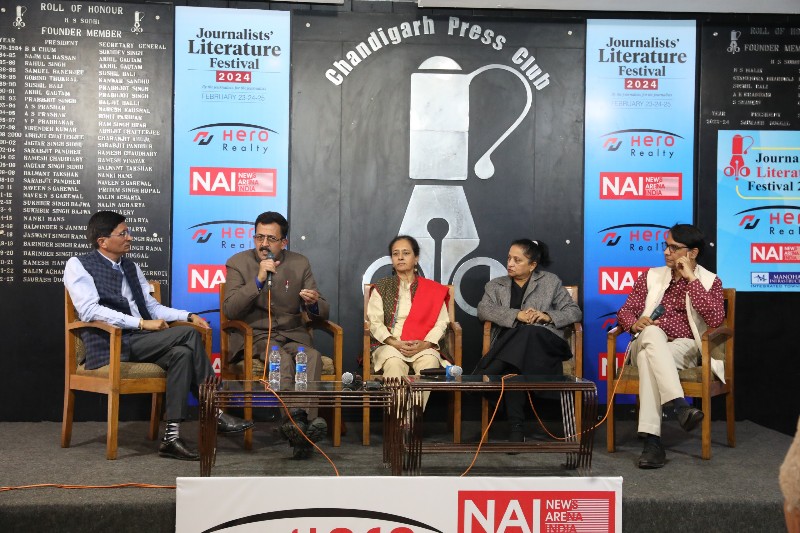Chandigarh
24 February 2024
DIVYA AZAD

The second day of the Journalists’ Literature Festival held at the Chandigarh Press Club in Sector 27, Chandigarh featured some of the brightest minds in journalism.
The day started with a session on the evolution of narrative in Hindi journalism, transitioning from short to long formats. Senior journalists and authors Asha Arpit, Mayank Mishra, Ranju Arey and Arun Naithani were part of the panel, which was moderated by journalist Barinder Singh Rawat.
Rawat started the session by remarking that Hindi journalism has indeed come a long way from days when the eligibility criterion for hiring a journalist was that he be passionate and be willing to work with just chickpeas as his sustenance to when vernacular journalists are taking home respectable packages. He also observed that leading minds are specially writing editorials in vernacular languages, which once upon a time had to be translated from English.

Tracing the origin of Hindi journalism from the days of the freedom struggle, Nithani remarked that the first Hindi weekly was published from Kolkata, a non-Hindi speaking region, after Independence it took up topics such as social justice and economic justice. He also emphasised on the importance of editorial pages, which are the brain of the newspaper
Arey, however, wistfully remembered the days when there was no race to break the news, and how this hurry has affected the credibility of journalism. She also urged newspapers to give space to short and long-form pieces instead of reducing all news to 100-word pieces to accommodate the reduced attention spans of the public. She recalled how long-pieces were written in the days of “bromide pasting” and how new technology had speeded up the news process. She also bemoaned that the quality of language used has been deteriorating by the day.
Underscoring the importance of providing all-round journalism, Arpit said, “The sahityak touch and old-world values of journalism have been lost. However, the packages are certainly good these days.”
On the rapidly shrinking gap between Hindi and English newspapers, Mishra commended the vernacular journalists for writing about issues, no one was writing about forcing the elite “babus” and vice-chancellors who in their own words only read English papers to read the Hindi papers as well. “Today, whether it is the Shatabdi or the airplane, you will get both Hindi and English newspapers. It was not always like this.”
‘India is not a cricket loving country, but a cricketer loving country’
The second session of the day saw a riveting discussion on ‘Sports in India: Cricket vs Others’, with seasoned cricket journalist Vijay Lokapally, television presenter Vikrant Gupta, and hockey writer Prabhjot Singh sharing their insights. It was moderated by Umesh Sharma.
On being asked by Sharma, why cricket is dominating over other sports, Lokapally credited the BCCI for making cricket glamorous. “Earlier, hockey players were given a great deal of importance, but after the 1983 World Cup Win, things changed. A major credit for it goes to the BCCI.”
Gupta, however, differed and insisted that the sport had been popular before ’83 as well as around 90,000 people would show up in stadiums, and people would get together to listen to it on the radio too.
On India’s love for cricket he said, “We all know that India is not a sports-loving country. It is a misconception that it is a cricket-loving country, it is actually a cricketer-loving country.”
He said that with the glamouraisation and the money flowing into it, the passion for cricket is reducing. Players are turning away Rs 2-lakh contracts for domestic matches!”
Gupta said that the footage and attention given to cricket is according to what people want to see, the day India won an Olympic medal in hockey at Tokyo the TRP was 180-190, but ton the day of a T20 match it would hit 1970. “So, the question is who is to blame. It should not be cricket versus others, it should be cricket and others.”
He also insisted that the BCCI should learn from IPL in the swiftess with which they let go non-performing players, rather than being swayed by emotion, which may cost the match.
Prabhjot Singh, asserted that the Chandigarh Press Club was the first to host a national seminar on hockey. Emphasising on the class divides reinforced by sports, he said, “It was the British who brought hockey, cricket and golf to India. Hockey was played in the cantonments by lower middle-class Indians, the middle, upper middle class and some royals preferred cricket, and the elites could play golf.”
He also weighed in on the economics of it, saying cricket had become cheaper, while other sports had become more expensive, which made the former more popular.
Lokapally also emphasised on the importance of maintaining your credibility, even if it meant roundly criticising players one is friends with.
‘Before Modi, Indira Gandhi used to do Mann Ki Baat’
The third, and one of the most anticipated sessions was on ‘political narratives in state and national elections: BJP versus the opposition’, which featured journalists Jagtar Singh, Manraj Grewal, Jatin Gandhi, and Nidhi Sharma.
Grewal set the ball rolling by asking whether the 2024 election was a one-horse race as isbeing projected. Sharma said, “It’s not over till its over. Look what happened to the India Shining Campaign. In 2019, even the BJP was not sure whether it would win for a second term, Pulwama was a Godsend. The BJP is looking confident, but if you go state by state and from regional player to regional player you might be surprised. One-month is a very long time in politics. The opposition also has a sense of urgency and the biggest challenge is to get the narrative straight. They cannot afford to look like plucked chickens! As journalists it is our responsibility to look at other factors driving the election.”
On the BJP’s superior messaging she said, “No matter them winning across states, they have not lost the fire in their belly. Just look at the Chandigarh mayoral election. No election is too small. Messaging is important. While PM Modi was one day seen speaking a Ujjwala scheme beneficiary about tea, the next day Rahul and Sonia were seeing making marmalade, which not a lot of people are able to relate to.”
“INC’s messaging is lost, few know that before Modi started Mann Ki Baat, Indira Gandhi also had her own programme on the All India Radio,” she said.
Gandhi, however, was of the opinion BJP’s narrative is not the Ram Temple, it is Ram Rajya. The BJP is agile when it comes to grasping opportunities. The temple is there, but the shelf life of it is limited, so it is a promise of Ram Rajya. “A newspaper piece analysed how the economy was good both under Modi and Manmohan Singh, but it is better at projecting narratives.
Jagtar Singh said that the freedom of expression is under threat. It is no ordinary election, the content and character of democracy in India is changing very fast. It is a very serious issue. Even innocuous tweets on the farmer protest is being taken down. Where is this country heading to? Are we heading towards dictatorship? Are we free to write, are we free to speak? I see little ray of hope of people standing up?”
‘The Pannun episode shows there is a trust-deficit between India and US’
The day concluded with a thought-provoking discussion on whether the India-US relationship stands as the most defining partnership of the 21st century. Journalists Ramesh Vinayak, Varghese K George, Rahul Singh, and Jayant Jacob shared their expert views on this significant topic.
On being asked by Vinayak about the Gurpatwant Singh Pannun assassination attempt, George said, “The fact that the United States would handle the Pannun case the way it did, speaks of a trust deficit. In fact, we do not know the whole truth of it.”
Rahul Singh said, “Trust is just beginning to grow between the two countries. One of the biggest deals is the purchase of jets and high-tech drones. These are crown jewels of defence tech. US needs India as a counterweight to China’s growing aspirations.”
He also asserted that India was no pushover when it came to China, as seen in Galwan where it managed to give China a bloody nose.
Jacob said that India-Us ties have gone through several ups and downs. The American establishment does not trust India very much as seen in the Pannun issue.




































